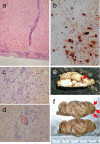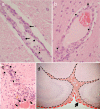Subclinical brain injury caused by H5N1 influenza virus infection
- PMID: 21389133
- PMCID: PMC3126180
- DOI: 10.1128/JVI.00239-11
Subclinical brain injury caused by H5N1 influenza virus infection
Abstract
Although H5N1 influenza A viruses can cause systemic infection, their neurotropism and long-term effects on the central nervous system (CNS) are not fully understood. We assessed H5N1viral invasion of the CNS and its long-term effects in a ferret model. An H5N1 virus caused nonsuppurative encephalitis, which lasted for 3 months without neurologic signs. Further, another H5N1 virus caused nonsuppurative vasculitis with brain hemorrhage. Three-dimensional analysis of viral distribution in the brain identified the olfactory system as a major route for brain invasion. The efficient growth of virus in the upper respiratory tract may thus facilitate viral brain invasion.
Figures



References
-
- Abdel-Ghafar A. N., et al. 2008. Update on avian influenza A (H5N1) virus infection in humans. N. Engl. J. Med. 358:261–273 - PubMed
-
- Anderson W. W., Jaros R. M. 1958. Neurologic complications of Asian influenza. Neurology 8:568–570 - PubMed
-
- Bell W. E., McKee A. P., Utterback R. A. 1958. Asian influenza virus as the cause of acute encephalitis. Neurology 8:500–502 - PubMed
-
- de Jong M. D., et al. 2005. Fatal avian influenza A (H5N1) in a child presenting with diarrhea followed by coma. N. Engl. J. Med. 352:686–692 - PubMed
Publication types
MeSH terms
LinkOut - more resources
Full Text Sources
Medical

